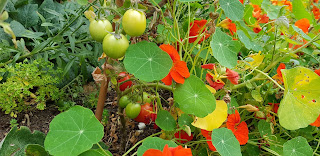We now have a brand new mushroom log. It was an early Christmas present. It was meant to be a normally timed Christmas present, but when my husband opened the package to check the instructions, it said we had to plant it out as soon as possible, so here it is. When I say plant it out, I actually mean bury it 15-20 cm deep in the ground so that it stands upright. The main purpose of this is for it to have the appropriate temperature and light levels. The mushrooms use the log rather than the soil to grow. The log's supposed to go in dappled shade, so I put it just behind my apple tree. It should take at least a year for any mushrooms to grow, but I'm looking forward to what they're going to look like as much as eating them. I think it makes a fine addition to my fernery.
I got the log from rusticmushrooms.co.uk. It's already been inoculated with mushroom spawn – in our case of oyster mushrooms. It was a nice simple way to grow mushrooms on a log, as it means we didn't have to source a log separately. But in case that's easy for you or you can't get hold of a pre-inoculated log, you can also buy spawn plugs and inoculate a log with them yourself. Here's some information on how to do that and what sort of logs work best.
I've left as many plants and seed-heads in the garden as possible this year, so that it doesn't just look bare over winter. Also, our local wildlife really appreciated the seed heads of my sunflowers. The birds peck at them, and we even watched a squirrel nibble through a stalk then run off with an entire head.




















































